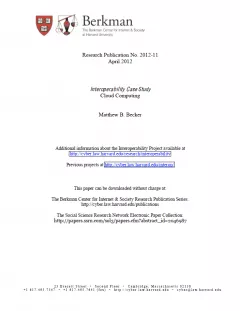
Interoperability Case Study: Cloud Computing
This case study is part of an ongoing series developed in support of a larger text on interoperability by John Palfrey and Urs Gasser - Interop: The Promise and Perils of Highly Interconnected Systems (Basic Books, June 2012).
The book is an extension of their 2007 study and paper, “Breaking Down Digital Barriers: When and How ICT Interoperability Drives Innovation” (Berkman Center Research Publication, 2007). Interop: The Promise and Perils of Highly Interconnected Systems focuses on the relationship between interoperability and innovation in the Information and Communication Technology (ICT) environment and beyond. Palfrey and Gasser seek to sharpen the definition of interoperability and identify its relevance for consumers, companies, governments, and the public by examining its driving forces and inhibitors, while considering how it can best be achieved, and why.
You can download this case study at SSRN.
From Urs Gasser's blog post about this publication:
In recent years, the growth of cloud computing has enabled users to utilize storage or processing power from geographically distant locations over the Internet. Cloud technologies have been lauded as a means for enhancing productivity, efficiency, and innovation by allowing on-demand network access to a shared pool of configurable networks, servers, applications, and services. According to a recent IBM study, the number of businesses adopting cloud computing to revamp existing business models will more than double by 2015, as business leaders are starting to view the cloud not just as a way to cut costs but also as a means for fundamental business innovation.
Due to the growing ubiquity of cloud computing in the digital world, examining issues of cloud interoperability offers profound insights about the legal, public policy, and technological challenges faced by businesses and other institutions engaged in this field. Berkman student fellow Matthew Becker’s recent case study on the topic, developed as part of our ongoing series on interoperability, suggests that greater scientific and technological reform, balanced with salient consideration of legal and social factors (such as user behavior and expectations), is required for successful interoperability in cloud computing.
Financial considerations can often drive small businesses “to the cloud.” Specifically, many businesses with underutilized IT departments have found cloud computing to be highly cost-effective. Simultaneously, on the end-user side, consumers have benefited from and enjoyed free or low-cost software from the cloud, which is becoming available on an increasing number of portable devices.
As explored in the case study and our book Interop, there are two integral dimensions to cloud computing interoperability: the vertical dimension and the horizontal dimension.
- The vertical dimension involves interoperability of software, applications, and data within a single cloud. In other words, from the consumer’s perspective, does the cloud-based software work or can the cloud-based data be accessed on most Internet-enabled devices? Can this software or data integrate other applications or additional data that the user’s devices can access?
- The horizontal dimension of cloud computing interoperability involves the concept of interoperability between clouds. In other words, how easily can a business that has cloud-hosted software or data transfer to an alternative cloud provider? Among other considerations, consistencies in cloud computing contracts, security features, privacy shields, authentication management, are vital when discussing this horizontal dimension of cloud computing interoperability. One of the primary foreseeable difficulties with cloud computing in the modern era is the possibility of a firm or individual becoming “locked-in” to the use of the cloud provider or platform with which they started.
You might also like
- communityThe Digital Panopticon Nightmare
- communityComparing Apples to Oranges
- communityCyberbullying linked to PTSD in children
